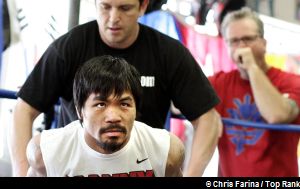
|
Philippines, 06 Jan 2026 |
Home >> News |
 |
||||
|
|
|
|
STRESS AND CORTISOL - A FOLLOW?UP TO ALEX ARIZA?S FINE ARTICLE By Ed de la Vega, DDS PhilBoxing.com Fri, 17 Jun 2011  Alex Ariza?s, ?Over-training, the Signs and Symptoms? published on Manny Pacquiao?s official website and re-posted on Philboxing.com should be a ?must read? for all boxers in training as well as trainers and managers. I highly recommend it too for all other athletes. Ariza?s detailed explanation related to stress and the hormone cortisol and what happens to the body when it is overworked was written very well. Granting that it may have been a wee bit too technical for the average Joe, never-the-less, it addressed the very important points about the topic. Cortisol is indeed a very important hormone and its importance to the physiology of the body could not be better stressed (no pun intended) than Ariza?s article. Cortisol and its effects related to stress has been a hot topic too not only to those involved in Exercise Physiology but in dentistry as well specifically, in relation to the use of properly designed mouthguards and their role in reducing the effects of stress and cortisol. While this may be a small surprise particularly to dentists and the public at large who are not involved in sports, the effect of stress in relation to the body physiology had been researched deeply by many involved with sports dentistry. Many articles have been published regarding the subject. In fact lately, the focus is on the specific design of mouthguards to produce an appliance that not only protect the alveolar process and dentition from impact forces thus reducing the likelihood of injury but also to significantly improve respiration, increase visual acuity, muscular strength and reduce discomfort associated with clenching during strenuous activities. The studies are centered on mouthguards designs to reposition the mandible to achieve the desired effects. The occlusal thickness of the mouthguards is given particular attention as studies indicate (Fuch, 1981) if the distance between the upper and lower teeth in increased by a certain measured amount there is an increase in isometric strength of the arms and the feet. Another study (Wang, et al, 1986) tested shoulder abduction strength and electrical impulses generated in upper muscle groups as well as a maximum voluntary contraction of these muscles in a supported rest position. The said study indicates that electrical activity was significantly greater when subjects were wearing a mouthguard that repositions the mandible in a certain way. Vergan et al in a 1980 published the results of a double blind study the results of which indicated that there was a significant increased in shoulder strength with those wearing a mouthguard device over those that did not. Francis and Brasher (1991) in a published study where athletes complained about breathing when wearing a protective mouthguard found paradoxically that physiological parameters improved when the athletes were wearing mouthguards during heavy exercise while oxygen consumption decreased, the forced expiratory air volume and peak expiratory flow rates also decreased. They concluded that the use of mouthguards resulted in physiologically more efficient breathing during heavy exercise. The effects of mouthguards are related to the ?fight or flight? response of the body and neurophysiological feedback mechanisms and the release of cortisol, the stress hormone mentioned by Ariza. Cortisol is released in response to physical exertion and a significant amount of these in the body results in physiological alterations that include reduction of performance, endurance, decreased metabolism and immuno-suppression. When the body is stressed, corticotrophin-releasing factor (CRF) is released which in turns stimulates the release of adenocorticotropic hormone (ACTH) which in turn increases the release of cortisol. The stress causes the clenching of teeth and the feed back mechanism that increases levels of cortisol, adrenalin and noradrenalin through the activation of the autonomic nervous system, including the hypothalamus.  One of our latest version of designer mouthguards. The use of a properly designed mouthguard that re-positions the mandible results in a non-functional bite which impedes these feedback mechanism. In addition, with the mandible repositioned by the mouthguard, the patency of nerves and arteries in the temporo-mandibular joint (TMJ) is improved, increasing blood flow and the perfusion of oxygen to the tissues, which in turn may improve function and strength. In conclusion, there is more to it than place a piece of plastic material in the mouth to serve as a ?mouth protector?, a mouthpiece so to speak. There is a science behind mouthguards, their design and function. Mouthguards, particularly those designed and fabricated by a knowledgeable professional (Sports Dentist) can potentially improve the over-all performance of athletes as well as protect them from possible injuries related to impact forces. Therefore, for all athletes looking to improve performance as well as to protect themselves from injuries, a properly designed and fabricated mouthguard is a must. Click here to view a list of other articles written by Ed de la Vega, DDS. |
|
|
PhilBoxing.com has been created to support every aspiring Filipino boxer and the Philippine boxing scene in general. Please send comments to feedback@philboxing.com |
PRIVATE POLICY | LEGAL DISCLAIMER
developed and maintained by dong secuya © 2026 philboxing.com. |